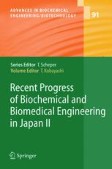Search
Search Results
-

-
Deconvolution Microscopy
Since its introduction in 1983, deconvolution microscopy has become a key image-processing tool for visualizing the cellular structures of fixed and...
-
Molecular Components of Physiological Stress Responses in Escherichia coli
In order to survive under and adapt to different conditions Escherichia coli has evolved elaborate systems that are able to sense and respond to...
-
Application of Knowledge Information Processing Methods to Biochemical Engineering, Biomedical and Bioinformatics Fields
In biochemical and biomedical engineering fields there are a variety of phenomena with many complex chemical reactions, in which many genes and...
-
Chemical Signalling in Beetles
This chapter reviews chemical structures of biologically active, volatile compounds in beetles. Techniques used for structure elucidation are briefly...
-
Total Internal Reflection Fluorescence Microscopy in Single Molecule Nanobioscience
Recent development in total internal reflection fluorescence microscopy (TIRFM) has made it possible to directly monitor the behaviors of...
-
Tracking Movement in Cell Biology
This article is an overview of techniques for measuring movement of proteins, vesicles and cells using digital image processing. Diverse techniques...
-
Metabolic Engineering
Metabolic engineering is a powerful methodology aimed at intelligently designing new biological pathways, systems, and ultimately phenotypes...
-
Cell-free Protein Synthesis Systems: Increasing their Performance and Applications
The Escherichia coli cell-free protein synthesis system can now be used for various proteins that need special requirements, such as disulfide bond...
-
Insect Chemical Defense
Research on the defensive chemistry of insects during the last decade is reviewed, with special emphasis on non-volatile compounds. The isolation and...
-
Fluorescence Lifetime Imaging Microscopy (FLIM)
Fluorescence lifetime imaging microscopy (FLIM) is a technique to map the spatial distribution of nanosecond excited state lifetimes within...
-
Spectral Imaging and Linear Unmixing in Light Microscopy
Fluorescence microscopy is an essential tool for modern biological research. The wide range of available fluorophores and labeling techniques allows...
-
Model-based Inference of Gene Expression Dynamics from Sequence Information
A dynamic model of prokaryotic gene expression is developed that makes considerable use of gene sequence information. The main contribution arises...
-
Bioprocess Monitoring Using Near-Infrared Spectroscopy
Near-infrared spectroscopy (NIR) is a nondestructive analytical technique that has been used for simultaneous prediction of the concentrations of...
-
Metabolic Flux Analysis Based on 13C-Labeling Experiments and Integration of the Information with Gene and Protein Expression Patterns
The recent progress on metabolic systems engineering was reviewed, in particular focusing on the metabolic flux analysis (MFA) based on the...
-
Transgenic Birds for the Production of Recombinant Proteins
Transgenic birds were expected to be an excellent transgenic bioreactor for the production of recombinant pharmaceutical proteins. However, the only...
-
Vertebrate Limb Regeneration
In this chapter, we have touched upon some of the key processes of vertebrate limb regeneration from the formation of the wound epithelium to pattern...
-
Mammalian Fetal Organ Regeneration
The develo** fetus has the remarkable ability to heal dermal skin wounds by regenerating normal epidermis and dermis with restoration of the...
-
Regenerative Capacity and the Develo** Immune System
Many components of the vertebrate immune system have evolved with dual, interrelated functions of both protecting injured tissues from infection and...
-
Stem Cells in CNS and Cardiac Regeneration
The central nervous system (CNS) and the heart muscle regenerate poorly after injury, yet evidence is mounting that both harbor cells capable of...
